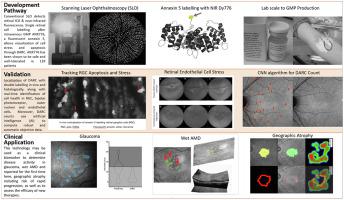Progress in Retinal and Eye Research ( IF 18.6 ) Pub Date : 2021-06-05 , DOI: 10.1016/j.preteyeres.2021.100976 Maria Francesca Cordeiro 1 , Daniel Hill 2 , Radhika Patel 3 , Paolo Corazza 3 , John Maddison 4 , Saad Younis 3

|
DARC (Detection of Apoptosing Retinal Cells) is a retinal imaging technology that has been developed within the last 2 decades from basic laboratory science to Phase 2 clinical trials. It uses ANX776 (fluorescently labelled Annexin A5) to identify stressed and apoptotic cells in the living eye. During its development, DARC has undergone biochemistry optimisation, scale-up and GMP manufacture and extensive preclinical evaluation. Initially tested in preclinical glaucoma and optic neuropathy models, it has also been investigated in AMD, Alzheimer's, Parkinson's and Diabetic models, and used to assess efficacy of therapies. Progression to clinical trials has not been speedy. Intravenous ANX776 has to date been found to be safe and well-tolerated in 129 patients, including 16 from Phase 1 and 113 from Phase 2. Results on glaucoma and AMD patients have been recently published, and suggest DARC with an AI-aided algorithm can be used to predict disease activity. New analyses of DARC in GA (Geographic Atrophy) prediction are reported here. Although further studies are needed to validate these findings, it appears there is potential for the technology to be used as a biomarker. Much larger clinical studies will be needed before it can be considered as a diagnostic, although the relatively non-invasive nature of the nasal as opposed to intravenous administration would widen its acceptability in the future as a screening tool.
This review describes DARC development and its progression into Phase 2 clinical trials from lab-based research. It discusses hypotheses, potential challenges, and regulatory hurdles in translating technology.
中文翻译:

用 DARC 检测视网膜细胞应激和细胞凋亡:从实验室到临床的进展
DARC(凋亡视网膜细胞检测)是一种视网膜成像技术,在过去 2 年中从基础实验室科学发展到 2 期临床试验。它使用 ANX776(荧光标记的膜联蛋白 A5)来识别活眼中的应激细胞和凋亡细胞。在其发展过程中,DARC 经历了生化优化、放大和 GMP 制造以及广泛的临床前评估。最初在临床前青光眼和视神经病变模型中进行测试,它还在 AMD、阿尔茨海默氏症、帕金森氏症和糖尿病模型中进行了研究,并用于评估治疗效果。进入临床试验的进展并不快。迄今为止,已发现静脉注射 ANX776 在 129 名患者中是安全且耐受性良好的,其中包括来自第一阶段的 16 名和来自第二阶段的 113 名。最近公布了青光眼和 AMD 患者的结果,并建议使用人工智能辅助算法的 DARC 可用于预测疾病活动。本文报道了 GA(地理萎缩)预测中 DARC 的新分析。尽管需要进一步的研究来验证这些发现,但该技术似乎有可能用作生物标志物。在将其视为诊断方法之前,还需要进行更大规模的临床研究,尽管与静脉给药相比,鼻腔给药的相对无创性将在未来扩大其作为筛查工具的可接受性。尽管需要进一步的研究来验证这些发现,但该技术似乎有可能用作生物标志物。在将其视为诊断方法之前,还需要进行更大规模的临床研究,尽管与静脉给药相比,鼻腔给药的相对无创性将在未来扩大其作为筛查工具的可接受性。尽管需要进一步的研究来验证这些发现,但该技术似乎有可能用作生物标志物。在将其视为诊断方法之前,还需要进行更大规模的临床研究,尽管与静脉给药相比,鼻腔给药的相对无创性将在未来扩大其作为筛查工具的可接受性。
这篇综述描述了 DARC 的发展及其从基于实验室的研究进入 2 期临床试验的进展。它讨论了翻译技术的假设、潜在挑战和监管障碍。











































 京公网安备 11010802027423号
京公网安备 11010802027423号